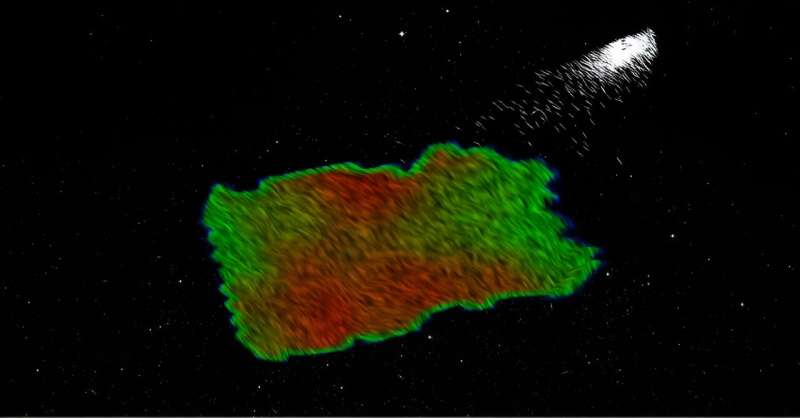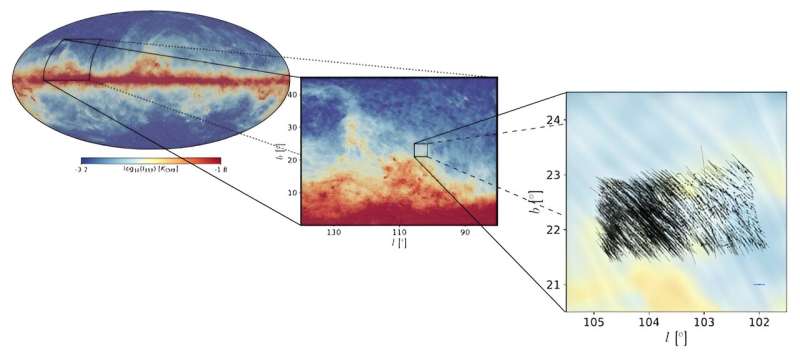A measured area in the sky. Left: A full-sky image of the polarized glow from dust seen at low resolution by ESA’s Planck satellite. This emission is a veil of dust that obscures our view of the early universe. Center: Map zoomed into the survey area. Right: Close-up of the survey area. Each black section corresponds to the measured polarization of a single star. The orientation of the segments maps the corresponding direction of the magnetic field in that region. Credit: Astronomy and Astrophysics (2024). DOI: 10.1051/0004-6361/202349015
Thanks to new cutting-edge technologies and state-of-the-art facilities, astronomy has entered a new era where the depths of the sky can finally be understood. The composition of our cosmic home, the stars, gases, and magnetic fields of our galaxy, can finally be mapped in 3D.
The space between the stars is dirty. It is filled with small dust particles, most of which are similar in size to cigarette smoke. These particles are not spherical, so their long axes tend to align with any local galactic magnetic field. These dust particles also emit polarized light at the same frequency as the cosmic microwave background (the “ash” of the Big Bang), contaminating our view of the earliest moments of life in the universe.
They also absorb some of the starlight that passes through them, acting like polarizing filters, imprinting information about their magnetic field onto the polarization of the emerging light. Polarization is a property of light that represents the characteristic direction of light, which is always perpendicular to the direction of light propagation in space.
Magnetic fields are extremely important to the evolution of the Milky Way, regulating the formation of new stars, shaping the structure of the Milky Way, and turning gas flows into cosmic accelerators more powerful than CERN.
Then the polarization of starlight is key: it holds information about the all-important magnetic fields of galaxies, and it is the “rag” that can help clean our view of the early universe—if only we can observe enough. Extract all the information it carries.
This is exactly the scope of the PASIPHAE survey, an international collaboration between the Institute of Astrophysics FORTH (IA-FORTH) and the University of Crete in Greece, IUCAA in India, the South African Observatory in South Africa, and the California Institute of Technology in the United States. University. PASIPHAE is designed to measure the polarization of millions of stars across much of the sky. We now have a first look at what this ambitious endeavor is capable of.
A research team led by Dr. Vincent Pelgrims (formerly PASIPHAE Postdoctoral Scholar at IA-FORTH and currently a Marie Curie Fellow at the Inter-University Institute for High Energy Research at ULB, Belgium) demonstrated the power of PASIPHAE data and reconstruction using its predecessor instrument, the RoboPol polarimeter. Observations performed over the past 10 years at the Skinakas Observatory in Greece.
The scientists measured the polarization of more than 1,500 stars in a sky nearly 15 times the area of the full Moon, combining them with the distance to each star measured by ESA’s Gaia satellite and a complex algorithm they developed using the magnetic field in that direction of the sky. An unprecedented analysis was obtained.
“This is the first time such a large volume of the galactic magnetic field has been reconstructed in three dimensions with such fine resolution,” said Dr. Pelgrims. “We discovered several dust clouds in this region of the Milky Way, and for the first time we were able to determine their distances (up to thousands of light-years long) as well as their polarization properties, revealing the magnetic fields that permeate these clouds.”
The team is releasing the first high-resolution tomogram of the galactic magnetic field across much of the sky, publishing it today (April 23) in the journal Astronomy and Astrophysics.

The relief pattern shows a 3-dimensional map of the magnetic field structure in one of the Milky Way’s interstellar clouds, with the colors showing the amount of dust. The white portion depicts the stars observed to achieve this mapping. Credit: Astronomy and Astrophysics (2024). DOI: 10.1051/0004-6361/202349015
“This represents a great achievement in the three-dimensional mapping of the Milky Way and its magnetic field,” said Professor Vasiliki Pavlidou, University of Crete, IA-FORTH affiliated faculty member and co-author of the publication. “The structure of the Milky Way’s magnetic field is not yet well understood. Good constraints.
“This has hindered progress in several areas of research, such as the study of ultra-high-energy cosmic rays. The potential for this kind of 3D mapping to lead to breakthroughs in all areas related to the galactic magnetic field is huge.”
“In our paper we only scratch the surface of future possibilities,” said Professor Konstantinos Tassis, also from the University of Crete and affiliated faculty at IA-FORTH. Co-author of the publication and principal investigator of the publication.
“Imagine a map like this – but for most of the sky. This 3D atlas of the Milky Way’s magnetic field will become a reality in the next few years, with the help of the specialized instrument WALOP, which will begin to map the polarization of stars in the Milky Way. picture.
More information:
V. Pelgrims et al., First degree scale tomography of the magnetized interstellar medium based on starlight polarization, Astronomy and Astrophysics (2024). DOI: 10.1051/0004-6361/202349015
Provided by the Institute of Astrophysics
citation: The first look at the Milky Way’s magnetic field in 3D (2024, April 23), Retrieved April 23, 2024 from https://phys.org/news/2024-04-glimpse-galaxy-tropical-field-3d. html
This document is protected by copyright. No part may be reproduced without written permission except in the interests of fair dealing for private study or research purposes. Content is for reference only.
#Milky #Ways #magnetic #field
Image Source : phys.org
